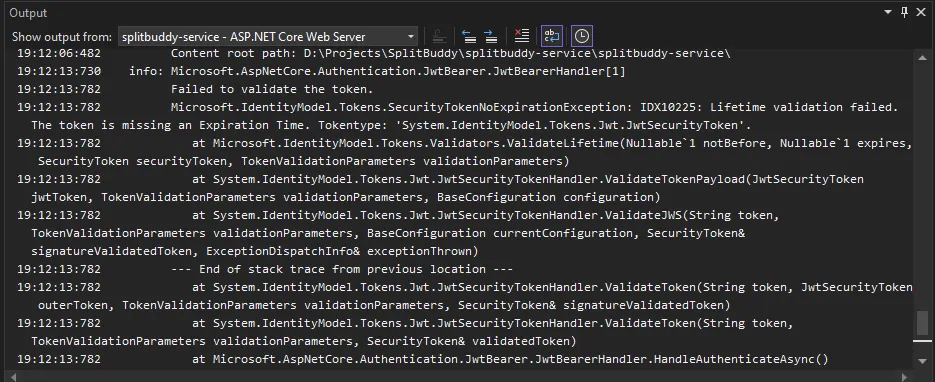我正尝试在我的 asp.net core webAPI 上尽可能简单地实现 JWT 身份验证。我不知道我缺少了什么,但即使使用正确的 bearer token,它始终返回 401。
以下是我的 configureServices 代码:
public void ConfigureServices(IServiceCollection services)
{
services.AddAuthentication(x =>
{
x.DefaultAuthenticateScheme = JwtBearerDefaults.AuthenticationScheme;
x.DefaultChallengeScheme = JwtBearerDefaults.AuthenticationScheme;
}).AddJwtBearer(
x =>
{
x.RequireHttpsMetadata = false;
x.SaveToken = true;
x.TokenValidationParameters = new TokenValidationParameters
{
ValidateIssuerSigningKey = true,
IssuerSigningKey = new SymmetricSecurityKey(Encoding.ASCII.GetBytes("A_VERY_SECRET_SECURITY_KEY_FOR_JWT_AUTH")),
ValidateAudience = false,
ValidateIssuer = false,
};
}
);
services.AddControllers();
services.AddDbContext<dingdogdbContext>(options =>
options.UseSqlServer(Configuration.GetConnectionString("dingdogdbContext")));
}
这是我生成令牌的方式
[AllowAnonymous]
[HttpPost("/Login")]
public ActionResult<User> Login(AuthModel auth)
{
var user = new User();
user.Email = auth.Email;
user.Password = auth.Password;
//var user = await _context.User.SingleOrDefaultAsync(u=> u.Email == auth.Email && u.Password==auth.Password);
//if(user==null) return NotFound("User not found with this creds");
//starting token generation...
var tokenHandler = new JwtSecurityTokenHandler();
var seckey = new SymmetricSecurityKey(Encoding.ASCII.GetBytes("A_VERY_SECRET_SECURITY_KEY_FOR_JWT_AUTH"));
var signingCreds = new SigningCredentials(seckey, SecurityAlgorithms.HmacSha256Signature);
var token = tokenHandler.CreateToken(new SecurityTokenDescriptor
{
Subject = new System.Security.Claims.ClaimsIdentity(new Claim[] { new Claim(ClaimTypes.Name, user.Id.ToString()) }),
SigningCredentials = signingCreds,
Expires = DateTime.UtcNow.AddDays(7),
});
user.Token = tokenHandler.WriteToken(token);
return user;
}
我在 app.useRouting() 后添加了 app.useAuthorization()。当我向 /Login 发送 POST 请求时,会收到令牌。但是,当我在 Postman 中使用该令牌查询任何其他端点时(将令牌添加到授权/JWT中),每次都会收到“401未经授权”的错误消息。我还有什么遗漏的吗?
